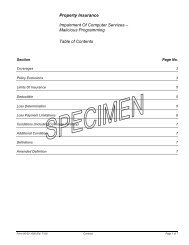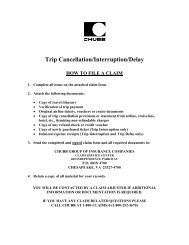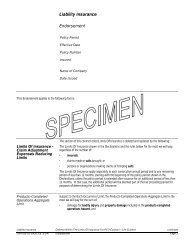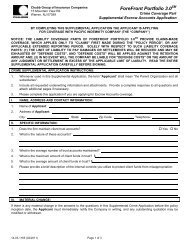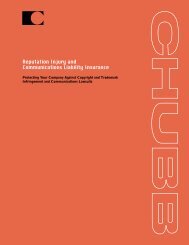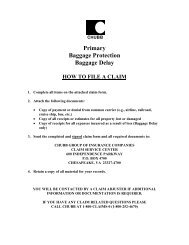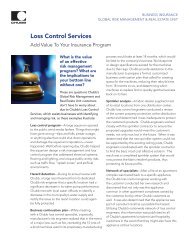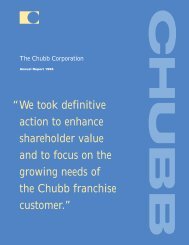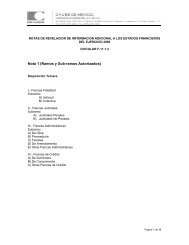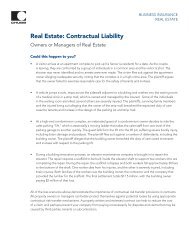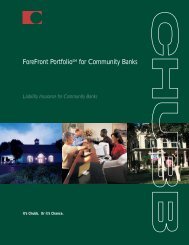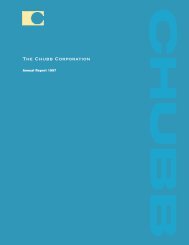Annual Report 2005 - Chubb Group of Insurance Companies
Annual Report 2005 - Chubb Group of Insurance Companies
Annual Report 2005 - Chubb Group of Insurance Companies
Create successful ePaper yourself
Turn your PDF publications into a flip-book with our unique Google optimized e-Paper software.
(7) Unpaid Losses and Loss Expenses bodily injuries asserted by those who came in contact<br />
with asbestos or products containing asbestos. Early<br />
The process <strong>of</strong> establishing loss reserves is complex court cases established the ""continuous trigger'' theory<br />
and imprecise as it must take into consideration many with respect to insurance coverage. Under this theory,<br />
variables that are subject to the outcome <strong>of</strong> future events. insurance coverage is deemed to be triggered from the<br />
As a result, informed subjective estimates and judgments time a claimant is Ñrst exposed to asbestos until the<br />
as to the P&C <strong>Group</strong>'s ultimate exposure to losses are an manifestation <strong>of</strong> any disease. This interpretation <strong>of</strong> a<br />
integral component <strong>of</strong> the loss reserving process. policy trigger can involve insurance companies over<br />
Most <strong>of</strong> the P&C <strong>Group</strong>'s loss reserves relate to long many years and increases their exposure to liability.<br />
tail liability classes <strong>of</strong> business. For many liability claims<br />
New asbestos claims and new exposures on existing<br />
signiÑcant periods <strong>of</strong> time, ranging up to several years or<br />
claims have continued unabated despite the fact that usage<br />
more, may elapse between the occurrence <strong>of</strong> the loss, the<br />
<strong>of</strong> asbestos has declined since the mid-1970's. Each claim<br />
reporting <strong>of</strong> the loss and the settlement <strong>of</strong> the claim. The<br />
filing typically names dozens <strong>of</strong> defendants to ensure that<br />
longer the time span between the incidence <strong>of</strong> a loss and<br />
there is a solvent company left in the group to eventually<br />
the settlement <strong>of</strong> the claim, the more the ultimate settlepay<br />
claims. The plaintiffs' bar continues to solicit new<br />
ment amount can vary.<br />
claimants through extensive advertising and through asbestos<br />
There are numerous factors that contribute to the<br />
medical screenings. New asbestos cases are <strong>of</strong>ten filed in<br />
inherent uncertainty in the process <strong>of</strong> establishing loss those jurisdictions with a reputation for judges and juries<br />
reserves. Among these factors are changes in the inÖation that are extremely sympathetic to plaintiffs. A vast majority<br />
rate for goods and services related to covered damages <strong>of</strong> asbestos bodily injury claims are filed by claimants who<br />
such as medical care and home repair costs; changes in do not show any signs <strong>of</strong> asbestos related disease.<br />
the judicial interpretation <strong>of</strong> policy provisions relating to<br />
There have been several positive recent developments<br />
the determination <strong>of</strong> coverage; changes in the general<br />
in the asbestos environment. Various challenges to mass<br />
attitude <strong>of</strong> juries in the determination <strong>of</strong> liability and<br />
screening claimants have been mounted. Also, a number<br />
damages; legislative changes; changes in the medical con<strong>of</strong><br />
key jurisdictions have adopted venue reform that<br />
dition <strong>of</strong> claimants; changes in the estimates <strong>of</strong> the<br />
requires plaintiÅs to have a connection to the jurisdiction<br />
number and/or severity <strong>of</strong> claims that have been inin<br />
order to Ñle a complaint. In addition, several states<br />
curred but not reported as <strong>of</strong> the date <strong>of</strong> the Ñnancial<br />
have enacted laws that set medical criteria that must be<br />
statements; and changes in the P&C <strong>Group</strong>'s underwritmet<br />
for plaintiÅs to proceed with their claims and other<br />
ing standards and/or claim handling procedures.<br />
states have medical criteria bills pending.<br />
In addition, the uncertain eÅects <strong>of</strong> emerging or potential<br />
claims and coverage issues that arise as legal, judicial<br />
To date, approximately 75 manufacturers and distribuand<br />
social conditions change must be taken into considtection<br />
as a result <strong>of</strong> asbestos related liabilities. Certain <strong>of</strong><br />
tors <strong>of</strong> asbestos products have Ñled for bankruptcy pro-<br />
eration. These issues can have a negative eÅect on loss<br />
reserves by either extending coverage beyond the original<br />
these manufacturers and distributors have utilized a prac-<br />
underwriting intent or by increasing the number or size<br />
tice referred to as a prepackaged bankruptcy, which<br />
<strong>of</strong> claims. As a result <strong>of</strong> such issues, the uncertainties<br />
involves an agreement to a plan between the debtor and<br />
inherent in estimating ultimate claim costs on the basis <strong>of</strong><br />
its creditors, including current and future asbestos claim-<br />
past experience have grown, further complicating the<br />
ants. Although the debtor is negotiating in part with its<br />
already complex loss reserving process.<br />
insurers' money, insurers are generally given only limited<br />
opportunity to be heard. In recognition that many aspects<br />
The future impact <strong>of</strong> the various factors that contribcertain<br />
<strong>of</strong> prepackaged bankruptcy plans are unfair to<br />
ute to the uncertainty in the loss reserving process and <strong>of</strong><br />
classes <strong>of</strong> claimants and to the insurance industry,<br />
emerging or potential claims and coverage issues is excourts<br />
these plans are beginning to be closely scrutinized by the<br />
tremely hard to predict and cannot be quantiÑed.<br />
and rejected when<br />
appropriate.<br />
The P&C <strong>Group</strong>'s most signiÑcant individual asbestos<br />
exposures involve products liability on the part <strong>of</strong> ""tradi-<br />
tional'' defendants who were engaged in the manufac-<br />
ture, distribution or installation <strong>of</strong> asbestos products.<br />
The P&C <strong>Group</strong> wrote excess liability and/or general<br />
liability coverages for these insureds. While these in-<br />
sureds are relatively few in number, their exposure has<br />
increased in recent years due to the increased volume <strong>of</strong><br />
claims, the erosion <strong>of</strong> much <strong>of</strong> the underlying limits and<br />
the bankruptcies <strong>of</strong> target defendants.<br />
The estimation <strong>of</strong> loss reserves relating to asbestos and<br />
toxic waste claims on insurance policies written many<br />
years ago is subject to greater uncertainty than other<br />
types <strong>of</strong> claims due to inconsistent court decisions as well<br />
as judicial interpretations and legislative actions that in<br />
some cases have tended to broaden coverage beyond the<br />
original intent <strong>of</strong> such policies and in others have expanded<br />
theories <strong>of</strong> liability. The insurance industry as a<br />
whole is engaged in extensive litigation over these coverage<br />
and liability issues and is thus confronted with a<br />
continuing uncertainty in its eÅorts to quantify these<br />
exposures.<br />
Asbestos remains the most signiÑcant and diÇcult mass<br />
tort for the insurance industry in terms <strong>of</strong> claims volume<br />
and dollar exposure. Asbestos claims relate primarily to<br />
The P&C <strong>Group</strong>'s other asbestos exposures involve<br />
products and non-products liability on the part <strong>of</strong> ""peripheral''<br />
defendants, including a mix <strong>of</strong> manufacturers,<br />
distributors and installers <strong>of</strong> certain products that con-<br />
tain asbestos in small quantities and owners or operators<br />
F-13



